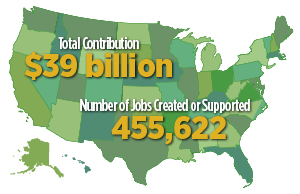New data recently released by NAFSA: Association of International Educators indicate that the more than one million international students studying at U.S. colleges and universities during the 2017-18 academic year contributed $39 billion to the U.S. economy, while at the same time supporting more than 450,622 jobs. These numbers represent a 1.2% increase in job support and creation and a 5.8% increase in dollars contributed to the economy compared to the previous academic year.
NAFSA’s full report shows the benefits of international students in the United States, including enrollment data, economic contributions, and jobs supported. Particularly for jobs supported, the report finds that for every seven international students enrolled, three U.S. jobs are created.
Esther D. Brimmer, NAFSA Executive Director and CEO, stated the following about the new data:
“The data continue to demonstrate that international students and scholars are a tremendous asset to our nation, contributing billions of dollars to our economy, thus generating hundreds of thousands of jobs in our local communities. And this is in addition to the immeasurable academic, security and cultural value these students bring. International students and scholars create jobs, drive innovation and serve as America’s best ambassadors and allies.”
NAFSA conducts an annual state-by-state and congressional district analysis of the economic contributions of international students and their families to the U.S. economy. This year, once again 10 states, including California, New York, Massachusetts, Texas and Pennsylvania, broke the $1 billion mark in contributions from international students. These states received a large contribution to their economy from spending by international students on living expenses, tuition and fees. The analysis also shows that with every seven enrolled international students, three U.S. jobs are created by spending in higher education, accommodation, dining, retail, transportation, telecommunications and health insurance.
State- and district-specific information can be accessed here.

